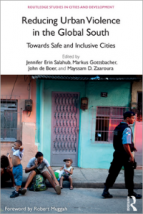Reducing Urban Violence in the Global South: Towards Safe and Inclusive Cities

Violence isn’t a straightforward concept. Mahadevia and Desai, in their chapter on everyday violence in the Indian cities of Ahmedabad and Guwahati, acknowledge that Indian cities don’t have the high levels of violence reported for certain cities in Latin America and Africa. Yet they refer to the less direct structural violence, where social structures or institutions, rather than individuals or groups, can cause harm through deprivation. These authors argue that via a neoliberal framework that declares certain parts of a city illegal, and thus prevents their residents from accessing basic services, “the urban planning paradigm has institutionalised structural violence within India’s cities” (page 179). Discriminatory granting of access to land rights leads to violent resistance. And the government’s withdrawal from certain governance and service functions means for instance that more women need to rely on open-jeep paratransit and poorly lit roads, reducing their safety. Thus, infrastructural deficits and development-induced resettlement, in this chapter’s analysis, are forms of everyday structural violence.
Another chapter examines the effectiveness of South Africa’s Community Work Programme (CWP) in reducing violence in Johannesburg and Cape Town. This programme guaranteed 100 days of low-paid work, per year, to unemployed citizens. Work included cutting grass, caring for elderly people, cleaning streets, organizing anti-crime campaigns, and supporting victims of domestic violence. “The CWP was not developed as a violence prevention programme but, as our research demonstrates, it presents a viable strategy to prevent violence in communities through addressing the underlying and direct causes of violence” (page 92). Some of the pathways were direct: cutting long grass and fixing streetlights made violence less likely in these spots. The programme also reduced recidivism among offenders hired into the programme. Overall, it showed the utility of economic and social inclusion as a means of reducing urban violence.
Together, the varied case studies in this book show that violence is about more than aggression, and policy responses need to be similarly wide-ranging.
“Whether focusing on the gendered dimensions of this issue or when working to prevent youth violence, economic incentives and empowerment initiatives have to address immaterial components such as social inclusion and efforts to look at social norms that prevent or emerge as a result. The reverse is also true: violence reduction initiatives need to address the challenges of economic exclusion, something that a more holistic approach to these issues would incorporate.” (page 223)
Available from:
https://www.routledge.com/Reducing-Urban-Violence-in-the-Global-South-To...
Further reading:
Environment and Urbanization (2014), “Conflict and violence in 21st century cities”, Vol 26, No 2, available at https://journals.sagepub.com/toc/eaua/26/2.
Muggah, Robert (2012), Researching the Urban Dilemma: Urbanization, Poverty and Violence, International Development Research Centre, Ottawa, available at https://www.idrc.ca/sites/default/files/sp/Images/Researching-the-Urban-....
Sommer, Marni, Suzanne Ferron, Sue Cavill and Sarah House (2015), “Violence, gender and WASH: spurring action on a complex, under-documented and sensitive topic”, Environment and Urbanization Vol 27, No 1, pages 105–116, available at https://journals.sagepub.com/doi/full/10.1177/0956247814564528.
Book note prepared by Christine Ro
Search the Book notes database
Our Book notes database contains details and summaries of all the publications included in Book notes since 1993 - with details on how to obtain/download.
Use the search form above, or visit the Book notes landing page for more options and latest content.
For a searchable database for papers in Environment and Urbanization, go to http://eau.sagepub.com/

